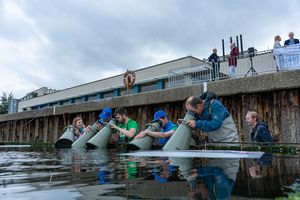Subtidal
Because sea levels are rising, many dikes in the Netherlands are being modified. How to design these dikes in such a way that water safety can be combined with a wealth of underwater nature, biodiversity and high productivity for fishing? That question can now be answered with the help of a unique underwater laboratory.
The underwater lab consists of 12 underwater basins with experimental underwater gardens, in the Eastern Scheldt, at the doorstep of NIOZ in Yerseke. Scientists and students will be conducting research into how human structures such as dyke coverings and embankments behave below the water line and what influence they have on ecological soil communities.
Innovative monitoring
The UnderwaterLab provides an excellent facility to test innovative measurement techniques of the subtidal environment due to its easy access and vicinity to lab analysis facilities. Within the scope of LCHT, three innovative monitoring techniques were tested:
- In-situ fluorescence
- Macrobenthos vacuum
- Orthomosaic monitoring of sessile flora and fauna
Below a presentation is provided summarising the techniques and the key results of the monitoring:
Innovative monitoring of subtidal environment in the UnderwaterLab
Referenties
- Innovative monitoring of subtidal environment in the UnderwaterLab, Tim van Oijen, 31 mei 2021.

